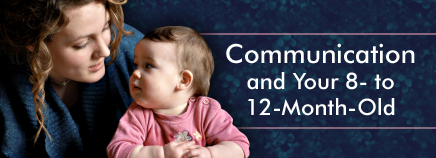
During these months, your baby might say “mama” or “dada” for the first time, and will communicate using body language, like pointing and shaking his or her head.
Your baby will pay even more attention to your words and gestures and will try very hard to imitate you — so be careful what you say!
How Babies Communicate
Babies this age test their verbal skills as they prepare for their big speaking debut. From babbling strings of consonants like “babababa,” they will begin to produce recognizable syllables, such as “ga,” “ba,” and “da.” By seeing their parents’ excitement at hearing “dada” or “mama,” babies soon learn to connect a word with its meaning.
Even before babies can talk, they communicate through gestures — pointing, shaking their head “no,” and waving bye-bye all demonstrate their ability to communicate, understand, and respond to language.
You’ll know your baby understands what you say when you ask “Where’s Daddy?” and your little one looks his way, or you point and say “Go find the blue ball” and he or she crawls right to it. Your baby should respond well to his or her own name, and should look up (and at least pause) when you say a firm “NO!”
By the end of the first year, your baby will follow simple requests from you (“Wave bye-bye”), enjoy peek-a-boo, say “mama” and “dada,” and babble with inflections of typical speech.
What Should I Do?
Continue talking to your baby using names as well as repetitive word games, like “This little piggy.” Ask your baby to point to familiar objects and ask “Where’s the cup?” Or point to a ball and ask “What’s that?” Pause before you provide the answer. Soon your baby will be pointing and saying “bah?” as though asking a question.
Labeling objects during the course of the day reinforces the message that everything has its own name. From milk in the morning to a teddy bear at night, naming familiar objects will help your little one learn what they’re called and store this information for the day when he or she can form the right words.
Make learning a whole-body experience: Touch your baby’s toe when you say the word “toe.” Or point out your own ear and say, “Mommy’s (or Daddy’s) ear.” Face your baby when you speak to let him or her see your facial expression and lip movements.
Be musical and sing to your baby to encourage language learning. By listening to the words, babies learn to recognize and repeat them. Throw in hand gestures and vary the style and tempo of the music to keep your baby’s attention. Babies also respond to rhymes, which show how playful language can be.
Read to your baby from large, colorful picture books, and encourage him or her to turn the pages. Give your baby a chance to “read” and “answer” your questions.
If You’re Concerned
By the 12 months, babies usually:
- respond to “no”
- follow simple commands
- use simple gestures, like pointing or shaking their heads
- say mama and dada
When it comes to language development, there is a wide range of normal. If you have concerns about your baby’s language skills or hearing, talk to your doctor.

